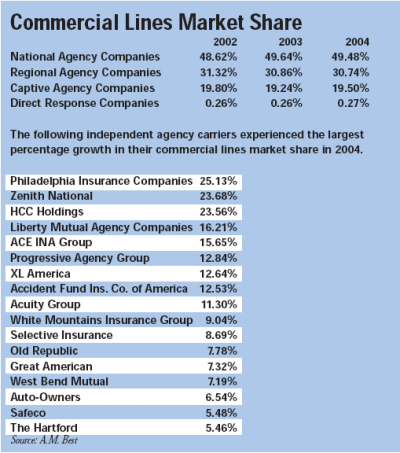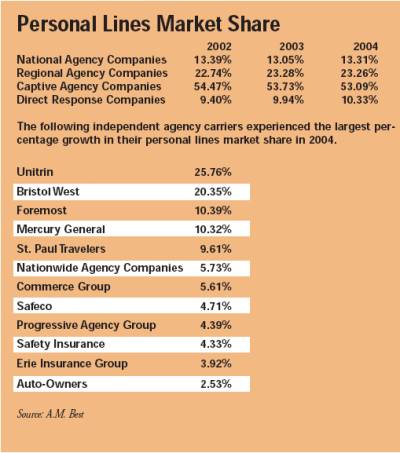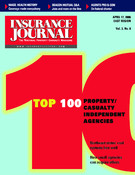Independent agents and brokers grew their share of the property/casualty market by $11.93 billion in 2004, accounting for almost 60 percent of the national increase, according to the Independent Insurance Agents and Brokers of America’s 2004 market share study.
The P/C market grew to $457.68 billion in direct written premium in 2004, with the overall market increasing by $20.69 billion, and independent agents writing $272.74 billion. While the overall P/C market grew by only 4.7 percent in 2004, compared to a 10.7 percent growth in 2003, agents and brokers produced 59.6 percent of the market in 2004 and 59.7 percent of the market in 2003. The growth in commercial and personal lines premium and market share in 2003 and 2004 resulted in a total $39.52 billion of new premium written by the independent agency distribution system.
“The results of this report clearly show that the independent agency system is flourishing,” said IIABA CEO Robert A. Rusbuldt. The results of the 2004 market share study reinforces the consumer and business acceptance of the independent agency and broker distribution model, and emphasizes the very real opportunities for growth that are present for independent agencies and brokers, IIABA stated.
The 2004 market share study marks the 10th year that the IIABA has contracted with A.M. Best Company to supply it with year-end industry market share and company expense data. IIABA analyzes this data annually to assess the state of the independent agency system.
“Independent agents are continuing to hold their own and to increase their market share,” said Madelyn Flannagan, IIABA vice president, education and research, who co-wrote the market share study. “While it might not seem like huge amounts, agents are continuing to see small increases and to me that’s a very positive trend.”
Flannagan added that as the industry continues to see the multi-million advertisements on television for direct writing companies, independent agents still offer great value to their community that direct writers cannot compete with. “They [agents] are still keeping the status quo and growing it,” she said.
“When you think about the fact that the tides could turn,” she said, “agents should be happy that the personalized service they provide is still reaching the customer and the customers are still buying from independent agents.”
Agents lead big in commercial lines
The independent agency system continues to have a dominant position in commercial lines in many states and has done a good job maintaining this position for much of the past decade, the IIABA stated. The commercial lines market is now larger than the personal lines market.
Independent agents held 80.22 percent of the commercial lines market share in 2004 compared to the 80.5 percent share of commercial lines in 2003. The commercial lines market grew 4.5 percent to $241.35 billion in 2004. The overall growth of the commercial lines sector was $10.31 billion in 2004 written premium as opposed to a $24.53 billion growth in 2003 indicating a softening market.
There has been very little change in the respective market shares for commercial lines held by the various distribution systems, according to the IIABA report.
National agency companies wrote 49.48 percent of the commercial lines market in 2004 while regional agency companies wrote 30.74 percent. In 2003, national agency companies wrote 49.64 percent of the commercial lines market while regional agency companies wrote 20.86 percent of the market. (See chart on page N17)
Philadelphia Insurance Companies (25.13 percent), Zenith National (23.68 percent), and HCC Holdings (23.56 percent) experienced the largest percentage growth in their commercial lines market share in 2004. (See chart on page N17)
The major captive agency writers that had the most significant changes in commercial lines market share were: Country Insurance and Financial Services (15.07 percent), Nationwide (7.14 percent) and American Family (6.57 percent).
There were also large variances among the states for commercial lines market share, and the IIABA report noted that there are many opportunities for independent agents and brokers to continue to grow their commercial lines share in wide variety of markets.
Independent agents in Hawaii wrote slightly more than 90 percent of the commercial lines market in 2004, while agents in Massachusetts, Rhode Island, Maryland and the District of Columbia wrote between 85 percent to 90 percent of the market.
In 30 states, independent agents and brokers write less than the national average commercial lines market share of 80.22 percent. In 2005, agents wrote 80-85 percent of the commercial lines market in 16 states; 75-80 percent in 18 states; 70-75 percent in five states; 65-70 percent in three states; 60-65 percent in three states; and 55-60 percent in one state.
Even though growth in both commercial lines and personal lines has slowed from the growth of the past three years, the IIABA said independent agents and brokers are reaping a significant dividend. The larger the market share they have in a particular market, the larger the dividend they accrue.
Flannagan says that in order to keep control over the commercial lines market, independent agents and brokers need to stay on top of today’s business trends and operations changes.
“To provide excellent service is one way agents will keep control but also working with their carriers to make sure the portfolios of products they offer address the changing needs of businesses today,” Flannagan said. “Ensure that your carriers are developing the products that your clients need, as well as understand the needs of clients and stay at the forefront of insurance knowledge and products.”
Personal lines
Independent agents and brokers and their carriers were again able to increase their personal lines market share slightly in 2004, according the market share report. However, they continue to control just a little more than one-third of the market.
National agency companies wrote 13.31 percent of the personal lines market in 2004 while regional agency companies wrote 23.26 percent. In 2003, national agency companies wrote 13.05 percent of the market while regional agency companies wrote 23.28 percent of the market. (See chart on page N17)
Captive agency companies wrote 53.09 percent of the personal lines market in 2004 while direct response companies wrote 10.3 percent. In 2003, captive agency companies wrote 53.73 percent of the market while direct response companies wrote 9.94 percent.
Unitrin (25.76 percent), Bristol West (20.35 percent), and Foremost (10.39 percent) experienced the largest percentage growth in their personal lines share in 2004 for independent agency companies. (See chart on page N17)
The major captive agency writers that had the most significant changes in personal lines market share were: American Express Group (19.73 percent), Progressive Direct (12.94 percent) and Geico (8.51 percent).
The personal lines market experienced a growth of 5 percent in 2004 to $216.33 billion following a 9.2 percent growth in 2003. Agents and brokers added $4.31 billion in premium in 2004, compared to the $6.69 billion in personal lines premium growth in 2003.
Independent agents and brokers increased their market share in personal lines by about a quarter of a percentage point to 36.57 percent in 2004. Personal lines presents a great opportunity for independent agents and brokers to increase their business, Flannagan says.
“Personal lines is something agents need to understand is an important component as they look to build their book of business; it’s not always just an accommodation anymore,” Flanagan said. “It’s a great opportunity for independent agencies to show their value to folks in their community.” Flannagan says that many independent agency carriers offer personal lines at a very competitive price.
“Growth can be achieved with focus, marketing strategies, improved technology, and new innovations,” Flannagan added.
State differences
Independent agency personal lines market share varies greatly by state. Northeast states have somewhat of an advantage, Flannagan says.
Massachusetts agents wrote 85.35 percent of the personal lines market in 2004, while Maine wrote 58.76 percent, and independent agents in Vermont, Connecticut and Rhode Island each had over a 50 percent share.
Flannagan said that those states have a regulatory climate that is more attractive to carriers so carriers are able to write business at a more competitive rate. She added that concentration in population is also a factor. “The customer bases are larger there,” she said.
To gain additional market share in the personal lines, agents need to work with their carriers and membership associations on legislation affecting the market, Flannagan said.
“But also many agents talk about ‘How do I become more profitable?’ … They are trying to grow their existing books of business but they are not considering that personal lines growth from the employees of their commercial clients would be a great way to start,” she said. “If they want to become more profitable then take a look at personal lines.”
Cutting costs
The overall cost structure for several independent agency companies is directly competitive with the major captive carriers and comes very close to the major direct companies, the IIABA report claims.
Because of the efforts of several personal auto independent agency carriers over the last several years to heighten their efficiency, their operating ratios or the overall expenses to provide insurance, compare well to the operating ratios of the major captive agency carriers. The operating ratios of some regional agency carriers beat those of the largest captive agent writers and met those of some of the direct writers.
The most efficient regional agency carrier based on the IIABA’s analysis was Lansing, Mich.-based Auto-Owners with an operating ratio of 26.48. USAA and Geico’s had operating ratios of 24.11 and 27.50, respectively.
Cost savings depends on the company and their ability to embrace technology, Flannagan said, as well as the carrier’s ability to help the agent embrace it. In order to keep the end results of their products and services competitive, carriers and agents are going to have to embrace technology, she said.
“You are not going to loose the human touch with your client if you embrace technology that helps you do your job more efficiently,” Flannagan said. “There are so many things being developed today that can make agencies do their job better and have more time to spend with their clients and therefore become more valuable and grow their business.”
In the future
“Independent agents and brokers continue to build on their market share, and if they keep working towards adopting new, efficient technology, strong marketing and branding strategies, and use their commitment and knowledge of their communities to their advantage, they will continue to build upon their present success,” said IIABA’s Rusbuldt.
Flannagan added that federal regulation could possibly help independent agents continue growth in market share, particularly for personal lines. “There are still a lot of antiquated rules and regulation that carriers are force to adhere to in some states so possibly federal regulation could bring them up to speed,” she said.
Flannagan says that the most important thing for agents is the consumer. “For independent agents to grow and prosper the consumer has to be their number one goal,” she said. “Independent agents and brokers have proven time and time again that they are innovative, resilient, and diligent in serving their customers and growing their businesses,” Rusbuldt added.
Was this article valuable?
Here are more articles you may enjoy.




 JPMorgan Client Who Lost $50 Million Fortune Faces Court Setback
JPMorgan Client Who Lost $50 Million Fortune Faces Court Setback  Progressive Gains as Drivers Shop Around for Auto Insurance—Again
Progressive Gains as Drivers Shop Around for Auto Insurance—Again  Vintage Ferrari Owners’ Favorite Mechanic Charged With Theft, Fraud
Vintage Ferrari Owners’ Favorite Mechanic Charged With Theft, Fraud  California Sees Two More Property Insurers Withdraw From Market
California Sees Two More Property Insurers Withdraw From Market 



